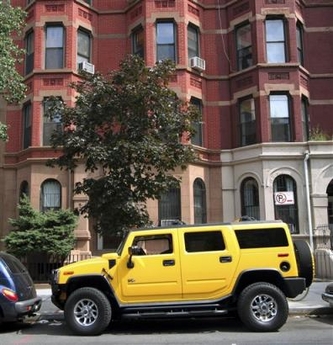Street Sense
 Hot Town, Hummer in the City. A Hummer H2 is parked in Brooklyn, New York, Thursday, Aug. 18, 2005. General Motors' full-size sport utility truck gets an estimated 10 miles-per-gallon (23.5 liters per 100 kilometers) in the city and 13 mpg (18 liters per 100 kilometers) on the highway. Gas prices soared to a record $2.55 per gallon in the U.S. last week, and some areas already are seeing prices at or above $3 a gallon. But automakers and industry watchers say the price spike isn't yet affecting consumers' car buying habits. (AP Photo/Mark Lennihan)
Hot Town, Hummer in the City. A Hummer H2 is parked in Brooklyn, New York, Thursday, Aug. 18, 2005. General Motors' full-size sport utility truck gets an estimated 10 miles-per-gallon (23.5 liters per 100 kilometers) in the city and 13 mpg (18 liters per 100 kilometers) on the highway. Gas prices soared to a record $2.55 per gallon in the U.S. last week, and some areas already are seeing prices at or above $3 a gallon. But automakers and industry watchers say the price spike isn't yet affecting consumers' car buying habits. (AP Photo/Mark Lennihan)In "Residents drive down speed limits," USA Today reports on citizen efforts to lower speeds in residential areas. It makes a point that I think is incorrect: "Residents whose neighborhood streets have no sidewalks and are carrying much higher traffic loads than they were designed for are spurred by compelling federal data: A pedestrian struck by a vehicle going 30 mph is three times as likely to die as one hit at 25 mph, and 86% of speeding-related fatalities occur off interstate highways." (Also see the related story "Texas lifts roadblock for cities to cut speed limits.")
The problem is that the average street is designed for much higher traffic load and speed than is appropriate for pedestrian-oriented areas, be they residential neighborhoods or walking-oriented commercial districts.
In any case, it's good to see forward movement on this issue.
Apparently, Planning Magazine, published by the APA, had an article in the May issue entitled "Complete the Streets!" about the need to make sure roadways are more than just about cars--and accommodate pedestrians, bicyclists, and transit--and are properly paved and cars move at speeds appropriate to the context.
All too often, streets are designed to accommodate cars moving fast as possible. That serves only one constituency for the road.
Other resources on this issue include Living Streets (UK), City Repair, "Great Streets," and the excellent report Living Spaces: Cleaner, Safer, Greener.



0 Comments:
Post a Comment
<< Home